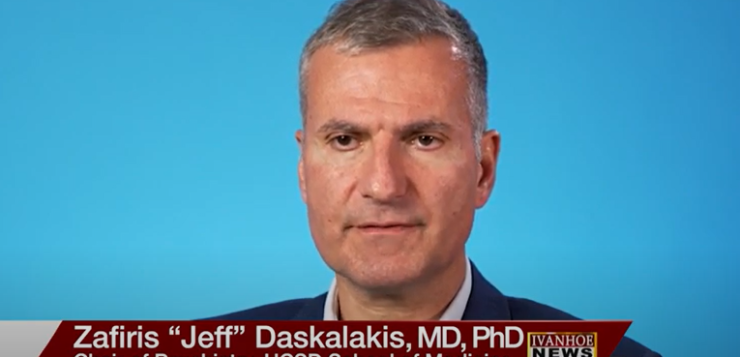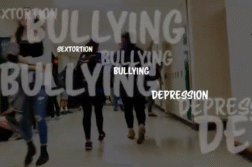Jeff Daskalakis, a psychiatrist, and the chairman of the Department of Psychiatry at UC San Diego, talks about how magnets treat depression.
Interview conducted by Ivanhoe Broadcast New in November 2021.
What is treatment-resistant depression?
PROF DASKALAKIS: Depression is an illness that affects about 6-7% of the population in any given year. About a third of those patients, roughly 2-2 1/2% of patients with depression, will not respond to conventional medications and psychotherapeutic treatment. That affects proportionately a small number of people, but at a population level it’s quite large. Treatment-resistant depression is that proportion of people who do not respond to conventional treatments.
What are the usual conventional treatments for depression?
PROF DASKALAKIS: Depression is typically treated through either medication, antidepressant medications, through psychotherapy or both. Treatment resistant depression is depression that has not responded, and by response, we typically expect people to be at least 50% better and ideally even 70% improved. And when patients don’t reach that threshold, they are defined from an academic lens as treatment resistant.
What is known about the causes or the origins of treatment resistance? Is it a cumulative pharmaceutical response? Is it something that genetic predisposition to?
PROF DASKALAKIS: So, there are a number of reasons why people don’t respond to medications and truthfully, we don’t know all the answers. There is a tremendous amount of research that is looking into what finds someone prospectively as being either treatment resistant or non-treatment resistant. You can imagine that is a key question. If you can predict who responds to a particular type of treatment, you’re likely to drive down health care costs and you’re likely to drive up the number of patients that can be treated at any one point in time. Be that as it may, we don’t have a deep appreciation for what the brain mechanisms are. People have conjectured that it may be related – and investigated that it may be related to serotonin, have investigated that may be related to a neurotransmitter called GABA, have also investigated other neurotransmitters, the NMDA neurotransmitter, which is tightly linked to our recent advancements of ketamine treatments. All this to say that there are a number of exciting avenues that are being explored currently, but we haven’t got our finger on exactly what leads to treatment-resistant depression.
One treatment, as I understand it, in the past has been electroconvulsive therapy. Can you talk about what that is, when it was appropriately used and what were the pros and cons of ECT?
PROF DASKALAKIS: Electroconvulsive therapy is an extraordinarily effective treatment to use when medications and psychotherapy have failed, particularly in severely ill patients, and oftentimes in those patients who are severely ill and experiencing suicidal thinking, want to kill themselves. It was developed in the ’30s and has had a convoluted history because of the nature of the treatment. It involves an electrical current, a low-grade electrical current that travels through the brain and excites neurons in the brain to fire at repetitive frequencies. And when neurons fire at those repetitive frequencies, they intend to synchronize, which then leads to the seizure. And we’ve known for some time that the seizure itself has tremendous therapeutic benefit, but that the delivery of the stimulus is also associated with significant side effects. And so, it is one of our most controversial treatments in psychiatry, in part because it works so effectively, but also in part because its history is checkered, it’s stigmatized and it does cause cognitive side effects, specifically memory, where people have trouble recalling old information, people have trouble laying down new information, and they can actually be quite confused after the treatment itself. So those three dimensions of cognitive side effects are oftentimes what patients find prohibitive about agreeing to a course of ECT. Despite that, ECT is an extraordinarily effective treatment when medications don’t work or when psychotherapy doesn’t work. And it can also be lifesaving in cases where people are acutely suicidal.
Now that we’re looking at the increased opportunities with magnetic-based therapies, of seizure therapy or magnetic stimulation, can you talk about the use of magnetism as a new therapy?
PROF DASKALAKIS: As I mentioned, electroconvulsive therapy works by delivering a repetitive electrical stimulus to the brain to induce a seizure. It turns out that you don’t necessarily need just a repetitive electrical stimulation, and magnets and magnetic fields can activate the brain in a very similar way. That is, a magnetic field can cause neurons to fire, particularly when it’s delivered at higher intensities and at higher frequencies. Neurons will fire together, and when neurons fire together they produce a seizure. So, the advantage of magnetic seizure therapy is that it produces the same type of seizure that electroconvulsive therapy produces, albeit in a way that is much more focal, doesn’t spread throughout the brain? And by virtue of the fact that it doesn’t spread throughout the brain, it actually protects and preserves certain brain circuits that are associated with memory formation. By preserving that circuitry that is associated with memory formation, you’re sparing memory. So, the advantage of magnetic seizure therapy over electroconvulsive therapy is that it simply does not have the same cognitive memory side effect profile that electroconvulsive therapy has.
Talk about what your interests and focus are at the moment with magnetic therapies. What answers or what questions are you trying to answer?
PROF DASKALAKIS: So, from a treatment perspective, we have been using magnetic stimulation to produce therapeutic effects in patients with severe psychiatric disorders; chief among those is depression. We’re using transcranial magnetic stimulation as a non-seizure inducing method to produce therapeutic effects. And there is growing evidence of its remarkable therapeutic effects in resistant depression. We’ve known for over 20 years now that TMS works, it’s FDA approved, and our clinics are currently offering TMS as a treatment for resistant depression. There are a proportion of patients who will not respond to TMS. That proportion is increasingly becoming smaller as we continue to develop new ways of stimulating the brain, new techniques to augment the therapeutic effect of transcranial magnetic stimulation. Despite that, we are still going to be left with a small proportion of the population that is unresponsive to TMS, unresponsive to medications, unresponsive to psychotherapy. And that’s where magnetic seizure therapy is used, or we hope that one day it will be used conventionally when these other treatments that I just mentioned no longer work. So, you’re moving into an area that is more invasive, but despite its increasing level of invasiveness, we’re protecting patients who are experiencing depression from experiencing the side effects that was conventionally experienced with ECT, and yet still preserving the brain function in an effort to optimize therapeutic response.
And looking ahead, how do you see the availability of TMS? Will it be something that is going to be limited to a few sites, a few clinics? Or is it a therapy that in time will be widespread, that somebody in a more remote place will be able to access? Or are we going to have to go to places like UCSD?
PROF DASKALAKIS: When I first started my career in TMS, very few people had heard about the treatment technique, and it was limited to a small group of top academic centers across North America and Europe. In the last couple of decades, we’ve seen an incredible expansion in the number of sites offering TMS for resistant depression, which has been very reassuring not only to me to see that expertise grow and be used as a therapeutic modality, but also the fact that we can now deliver a very safe and effective treatment with virtually no side effects to patients who are experiencing resistant depression is quite rewarding. I think in the future we’re going to continue to see a few things. We’re going to continue to see treatments that are effective, that take less time to develop and have less of an impact on patients’ lives, meaning that they don’t have to travel far to be able to receive the treatments. We’re going to start seeing smaller clinics be able to offer TMS clinics that make it extraordinarily efficient for commuters to make sure that they get the treatment that is helping them. We’re also going to see treatments that may one day be even available at home. This is a very safe treatment, there are few cautions, and once we make sure that it’s used in an extraordinarily safe way where the incidence of side effects there’s a very remote risk of seizures. In fact, the risk of seizures is oftentimes no more than it is with medications. Despite that, we want to limit with TMS any risk of seizures, any risk of side effects. And when we do that, when we’re convinced that it’s safe enough to be used at home, then we can even consider starting to allow patients to deliver the treatment or allow them to get the treatment in their home setting.
Can you talk about the relative costs of different treatments? Does TMS project out to be perhaps less expensive? Is TMS something that once you do it, you do it for the rest of your life or just till you got resolution of the issue as opposed to like a drug, which you might take forever?
PROF DASKALAKIS: There’s no question that either medications or psychotherapy are less costly than TMS, but when those treatments fail, there are few other options available. And electroconvulsive therapy is not only an expensive treatment, but also a treatment, as I mentioned, that is associated with significant side effects, so much so that only a fraction of the patient population that is experiencing resistant depression is agreeable to receiving electroconvulsive therapy. And that small fraction is typically limited to patients who are experiencing depression and oftentimes severe depression with suicidality. TMS brings down significantly the cost, the economic burden of depression on society by virtue of the fact that it can make a significant proportion of the population better in a short period of time. And you can imagine that across the U.S. there are millions of people who experience resistant depression and have nowhere to turn. Medications don’t work for them, and electroconvulsive therapy is not something that they would consider. TMS, when used to treat that group of resistant depression patients, not only gives them quality of life, not only does it give them symptomatic relief, but it actually helps people return to work and drives down the economic burden that is associated with depression.
END OF INTERVIEW
This information is intended for additional research purposes only. It is not to be used as a prescription or advice from Ivanhoe Broadcast News, Inc. or any medical professional interviewed. Ivanhoe Broadcast News, Inc. assumes no responsibility for the depth or accuracy of physician statements. Procedures or medicines apply to different people and medical factors; always consult your physician on medical matters.
If you would like more information, please contact:
Michelle Brubaker
Sign up for a free weekly e-mail on Medical Breakthroughs called First to Know by clicking here




